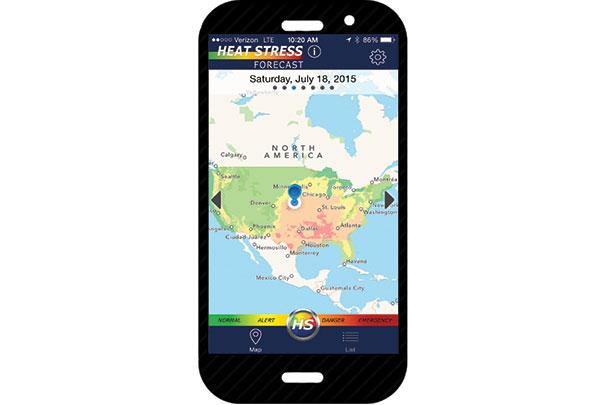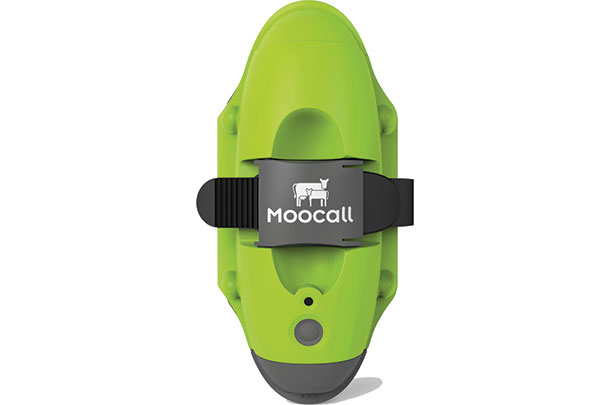Heat Stress app
A new app, aptly named “Heat Stress,” that indicates when upcoming forecasts might trigger heat stress in cattle, is now available in the App Store and Google Play.

After extensive beta-testing and years of research, the fruits of labor put forth by Tami M. Brandl-Brown, agricultural engineer with the USDA’s Agricultural Research Service (USDA-ARS) of Clay Center, Nebraska, and her team are happy to arm producers with this management tool.
After the National Weather Service (NWS) stopped providing daily alerts in the early 1990s, there was a void of information available to producers. Around 2005, the USDA-ARS developed a website, including impending heat stress risk alerts, that is still going today.
Realizing that the trend of producers utilizing smartphones for business purposes is on the rise, this app was developed out of a need to help out producers where they are at, Brandl-Brown says.
Based on key factors that increase the likelihood of heat stress, including temperature, humidity, wind speed and solar radiation, the app draws from data delivered by the NWS and puts it into an equation that results in a single parameter.
That parameter, similar to temperature-humidity index (commonly know as THI), indicates whether the heat stress risk is in one of four ranges: normal, alert, danger or emergency.
Each of these four risk ranges is displayed as a colored overlay on a map of the U.S.
“What we did was create an app that uses the same maps that we use on our website,” Brandl-Brown says. “When you open the app, you see a colorful map of the U.S. You can zoom in or out to your location, drop a pin where your operation is located and select the forecast time frame that you would like notifications.”
The team behind this app includes fellow USDA researchers such as Roger Eigenberg and Randy Bradley. Additionally, the team collaborated with a rural Nebraska company, Hollman Media LLC out of Kearney, to develop the interface of the app.
Producers can choose to view and receive alerts for forecasts up to seven days out. If where a user dropped a pin is in the danger or emergency range, a push notification is sent to their screen.
For producers with multiple operations in various locations, multiple pins can be dropped accordingly. Each pin can push separate notifications according to the forecasted heat advisories and user settings.
While this app can be useful for any livestock producer, it is especially relevant to feedlot managers.
“Cattle in the feedlot are on black soil, and that soil can exceed 150 degrees on a hot summer day,” Brandl-Brown notes. “They are on a higher- energy ration that makes them more susceptible to heat stress. That hot soil reflects heat back up to the cattle, so not only are they getting hot sun [from above], they are also getting heat from the soil [below].”
Additionally, Brandl-Brown and her team felt it was also important to equip producers with ways to recognize heat stress symptoms and management practices to lessen the level of heat stress animals experience during emergency-level days.
“In the settings, producers can find a section on recognizing heat stress,” Brandl-Brown notes. “We have populated this section with a series of pictures which display various signs of heat stress and what can be done to help cool the animals off.”
The information packed into this tool is based on extensive heat stress research of Brandl-Brown’s team and other scholars, such as John Goggins and Terry Mader.
A true culmination of efforts, this app is a tool that can be handed over to the people who are the target of the research behind it, Brandl-Brown notes. “To me, this completes the cycle of our research.”
MooCall
Nothing stings quite like the loss of a cow and her calf due to calving difficulties. For Niall Austin, however, this bitter disappointment led to a positive outcome with the development of a technology aimed at reducing the risk of complicated unassisted births.
Moocall was developed based on a need for an early warning device that could alert producers when calving is imminent. After losing a cow and calf pair while away from the operation on business and finding no suitable technology, Austin of Ireland spent the next four years researching and trialing the concept from which Moocall was created.
With the goal of lowering mortality rates in unassisted calvings, Moocall is an adjustable device strapped around the cow or heifer’s tailhead when a producer suspects the dam to be in labor within a matter of days. The device monitors labor and triggers an email or text alert prior to the calf arriving for producers to step in if necessary.

“The device has an advanced algorithm that measures all tail movements and records data by the second,” Peter Vallely, Moocall’s vice president of sales in North, Central and South America, says. “Prior to the onset of calving, there is an increased frequency and pattern in tail movement, creating a change in the algorithm that signals the device to text the subscribed cellular device.”
Alerts sent to the producer include increased regular updates in tail activity, calving in progress, battery life status and extended wear notifications aiming to reduce irritation from a mother wearing the device for longer than four days consecutively.
Moocall is a tool that not only monitors cattle throughout labor but also provides producers with some peace of mind.
“Moocall allows cattlemen to carry on with their days as normal, safe in the knowledge that a text and email will alert them if they need to be back for the calving,” Vallely says. “It is very beneficial at night; during calving some cattlemen are up every two hours to check on mothers, but Moocall allows them the option of sleep.”
Despite its initial market being most popular among dairy producers, more recent trends show a 50-50 split between dairy and beef producers using this tool. Founded in Europe, Moocall has been well received globally.
“There were 14,000 sensors sold in the first 14 months across 35 countries, and 94.8 percent of our customers renew their annual subscriptions,” Vallely notes. “To date, we have had 90,000 successful calvings.”
Beef producers have seen a return on investment and opportunity cost with Moocall, Vallely says. Due to logistical challenges, this device is best suited for cow herds set up to calve relatively nearby rather than in herds turned out on thousands of acres.
Rural location was also considered when developing this device; a signal booster is incorporated into the program of the sensor that aids in timely alerts. In addition to email and text alert capabilities, Moocall developers also offer an app now available on the App Store and Google Play.
With a short set-up period and long battery life, this device was designed for producers wanting to monitor cattle in labor without obstructing progress unless necessary. ![]()
PHOTO 1: Heat Stress app gauges temperature, humidity, wind speed and solar radiation, along with NWS data, to determine parameters for possible heat stress. That parameter, similar to temperature humidity index, indicates whether a heat stress risk is in one of four ranges: normal, alert, danger or emergency. Image courtesy of Hollman Media LLC.
PHOTO 2: Moocall is an adjustable device strapped around a cow or heifer’s tailhead when a producer suspects the dam to be in labor within a matter of days. Image courtesy of Moocall.

-
Danielle Schlegel
- Freelance Author
- Whitewood, South Dakota
- Email Danielle Schlegel






